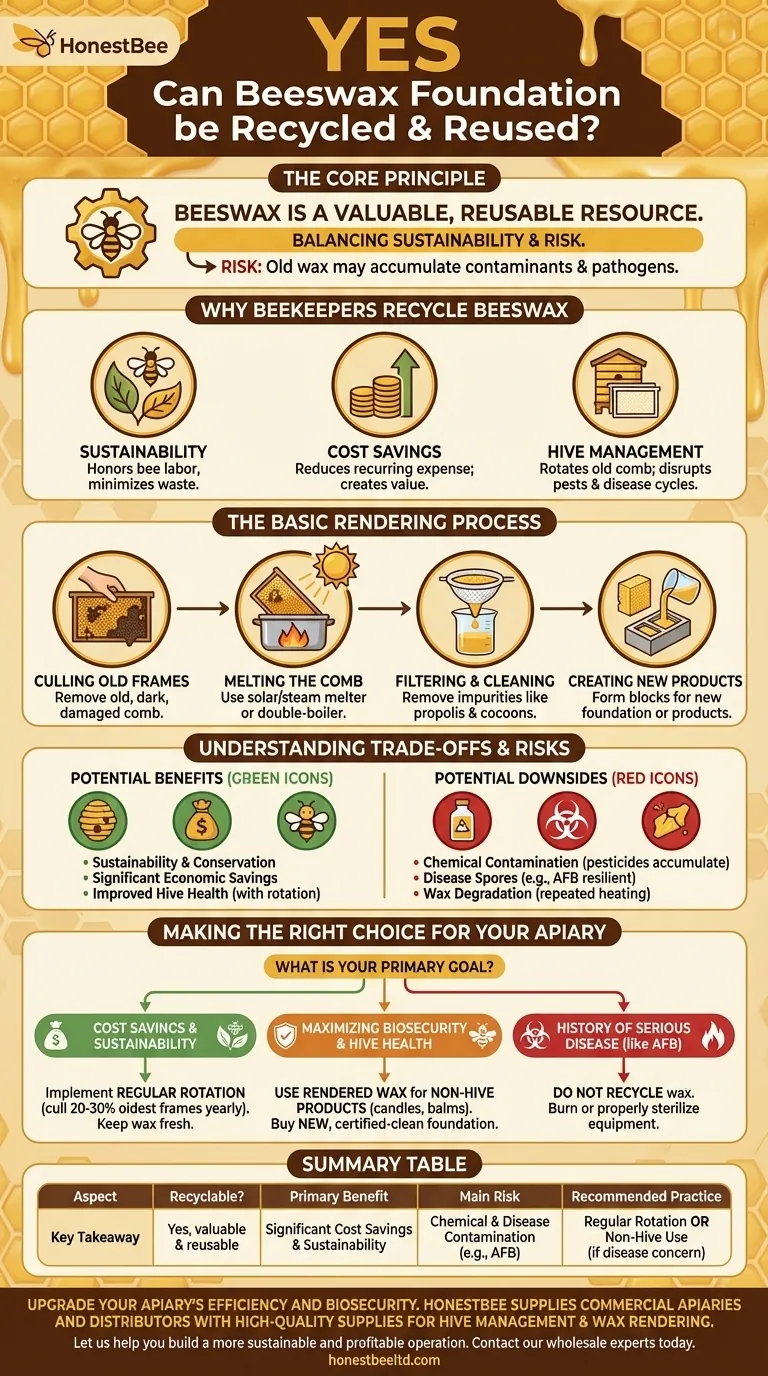Yes, absolutely. Beeswax foundation is not only recyclable but is a fundamental component of sustainable and economical beekeeping. Beekeepers regularly remove old or damaged foundation from frames, melt it down, and render the beeswax to be used again.
The core principle is that beeswax is a valuable, reusable resource. However, recycling it effectively requires a clear understanding of the risks, as old wax can accumulate contaminants and pathogens that may harm the hive if not managed properly.

Why Beekeepers Recycle Beeswax
Recycling beeswax is a long-standing practice rooted in practicality, economics, and a respect for the bees' labor.
The Principle of Sustainability
Bees expend a significant amount of energy to produce wax. Recycling this resource honors their effort and minimizes waste within the apiary.
Significant Cost Savings
Beeswax foundation is a recurring expense for beekeepers. Melting down old comb to create new foundation sheets or trading it for new equipment can lead to substantial savings.
A Tool for Hive Management
The act of recycling is part of a larger hive management strategy. Beekeepers regularly rotate out old, dark combs to encourage the bees to build fresh, clean wax, which can disrupt pest and disease cycles.
The Basic Rendering Process
Turning old, dark comb back into clean, usable beeswax is a process known as rendering.
Step 1: Culling Old Frames
Beekeepers identify and remove frames from the hive that contain old, dark brown or black comb, damaged foundation, or drone comb they wish to eliminate.
Step 2: Melting the Comb
The old comb and foundation are scraped from the frames and melted. This is commonly done using a solar wax melter, a steam wax melter, or a simple double-boiler setup for smaller batches.
Step 3: Filtering and Cleaning
Once melted, the liquid wax is filtered through cheesecloth or other fine screens to remove impurities. These include bee cocoons, propolis, pollen, and other hive debris. The process is often repeated to increase purity.
Step 4: Creating New Products
The clean, rendered beeswax is then poured into molds to form blocks. This block wax can be sold, traded, or used to create new foundation, candles, balms, or other beeswax products.
Understanding the Trade-offs and Risks
While beneficial, recycling beeswax is not without its challenges. Objectivity requires acknowledging the potential downsides.
The Risk of Chemical Contamination
Beeswax is lipid-based, meaning it readily absorbs fat-soluble substances. Pesticides, herbicides, and miticides used in agriculture or even within the hive can accumulate in the wax over several years. Remelting the wax does not remove these chemical residues.
The Threat of Disease Spores
More critically, the spores of serious bee diseases, such as American Foulbrood (AFB), are extremely resilient. They can survive in old wax and may not be eliminated by standard home-rendering temperatures, posing a significant risk of re-infecting a colony.
The Degradation of the Wax
Over time and with repeated heating, the quality of the wax can change. It may become more brittle or lose some of its characteristic aroma.
Making the Right Choice for Your Apiary
Your approach to wax recycling should be guided by your primary goals as a beekeeper.
- If your primary focus is cost-savings and sustainability: Implement a regular rotation system, culling and recycling your oldest 20-30% of frames each year to keep the wax in your hives relatively fresh.
- If your primary focus is maximizing biosecurity and hive health: Consider using your rendered wax for non-hive products like candles and purchasing new, certified-clean foundation for use inside the colony.
- If you have ever had a confirmed case of a serious disease like AFB: Do not recycle the wax from the affected equipment. The risk of spreading the disease is too high, and the equipment should be burned or properly sterilized.
Ultimately, managing your apiary's wax is a key skill that balances economic needs with the long-term health of your bees.
Summary Table:
| Aspect | Key Takeaway |
|---|---|
| Recyclable? | Yes, beeswax is a valuable, reusable resource. |
| Primary Benefit | Significant cost savings and sustainability. |
| Main Risk | Potential for chemical and disease contamination (e.g., American Foulbrood). |
| Recommended Practice | Regular rotation of old frames; use rendered wax for non-hive products if disease is a concern. |
Upgrade Your Apiary's Efficiency and Biosecurity
Managing your wax is crucial for hive health and your bottom line. HONESTBEE supplies commercial apiaries and beekeeping equipment distributors with the high-quality, durable supplies needed for effective hive management and wax rendering.
Let us help you build a more sustainable and profitable operation. Contact our wholesale experts today to discuss your equipment needs.
Visual Guide

Related Products
- Notebook Style Beeswax Foundation Mould Wax Foundation Mold
- Manual Beeswax Comb Foundation Machine Wax Foundation Mill Embossing Machine
- Electric Beeswax Foundation Machine With Operating Tray and Wax Foundation Roller
- Economy Manual Beeswax Embossing Mill Wax Foundation Machine Roller
- Electric Beeswax Flat Sheet Machine with Operating Tray for Wax Processing
People Also Ask
- What is the process for making beeswax sheets using a mold? A Step-by-Step Guide for Perfect Results
- How do you store beeswax foundation? Prevent Wax Moth Damage and Preserve Quality
- How is beeswax foundation installed and what are its characteristics? Boost Hive Health Naturally
- How do you use the Foundation Mold to create beeswax foundation? Master DIY Beekeeping with Precision
- What is beeswax foundation made of? A Guide to Stronger, More Efficient Hives














